
Here we have a list of Loaner Tools that the Chicagoland MG Club owns and maintains for use by its members. The intention of the club is to procure and hold some of the more expensive tools that folks may be hesitant to buy for themselves because of the expense and the limited usage by any one person. See Lending Policy at bottom of page.
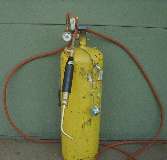 AIR-ACETYLENE TORCH:
AIR-ACETYLENE TORCH:
When order of the day is HEAT, this is what you need. It is a small (knee high) tank of acetylene with an air mixing torch. It works like a propane torch, very easy to use, but it has much hotter flame. This will not cut or weld steel like an oxy-acetylene torch, but it can be used for brazing or silver soldering. It also does a good job of heating stubborn rusted nuts and bolts and studs for removal. such as removing a broken stud from an exhaust manifold. If you're doing a complete front suspension rebuild or replacing leaf springs, this could come in handy. The tank must remain vertical during use. Please use dark goggles and gloves to protect your eyes and hands. If you borrow this tool you may be asked to pay a small fee to cover occasional refilling of the acetylene tank. Thanks to CMGC member Hal Elmore for contributing this tool.

ALIGNMENT GAUGE:
 When you work on your car’s front end, the toe-in should be checked and adjusted. Take a measurement off the back of the front tires, measure again at the front and read the difference off the large scale, adjust your tie rod ends and measure again. Thanks to CMGC member Seth Jones for contributing this tool.
When you work on your car’s front end, the toe-in should be checked and adjusted. Take a measurement off the back of the front tires, measure again at the front and read the difference off the large scale, adjust your tie rod ends and measure again. Thanks to CMGC member Seth Jones for contributing this tool.

DIAL BORE GAUGE:
 This instrument is used to measure engine block cylinder bore size, accurate to 0.0005-in. This may allow you to determine amount of wear in your cylinder bore, so you might decide if it needs a rebore and new pistons or if you might get away with honing and new piston rings. It can also be used to measure bore size of main and rod bearings for your crankshaft, scroll seal diameter at rear of a 3-main bearing Austin engine, or any other smooth bore hole from 2 to 4 inches diameter. Thanks to CMGC member Barney Gaylord for contributing this tool.
This instrument is used to measure engine block cylinder bore size, accurate to 0.0005-in. This may allow you to determine amount of wear in your cylinder bore, so you might decide if it needs a rebore and new pistons or if you might get away with honing and new piston rings. It can also be used to measure bore size of main and rod bearings for your crankshaft, scroll seal diameter at rear of a 3-main bearing Austin engine, or any other smooth bore hole from 2 to 4 inches diameter. Thanks to CMGC member Barney Gaylord for contributing this tool.
 EMERGENCY FLASHER LIGHT:
EMERGENCY FLASHER LIGHT:
The Club has bought an emergency flashing unit that can be used when towing a car. Place on back of towed vehicle.

ENGINE HOIST:
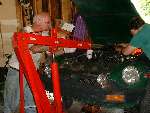 After many years of service our hoist was reported by some club members to be a little weak in lifting ability. A professional repair service has now replaced some of the seals and other components, and the hoist is now back to normal.
After many years of service our hoist was reported by some club members to be a little weak in lifting ability. A professional repair service has now replaced some of the seals and other components, and the hoist is now back to normal.

ENGINE STAND:
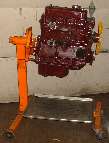 Yes we have one of these, and no, the engine doesn't come with it. But here's a tech page to help you see out how to use it. Using engine stands. This is a wonderful tool to use when disassembling and reassembling an engine, but we still ask that you do not keep it for more than a few days. If you need one for long term, they are not very expensive to buy.
Yes we have one of these, and no, the engine doesn't come with it. But here's a tech page to help you see out how to use it. Using engine stands. This is a wonderful tool to use when disassembling and reassembling an engine, but we still ask that you do not keep it for more than a few days. If you need one for long term, they are not very expensive to buy.

EXHAUST GAS ANALYZER #1:
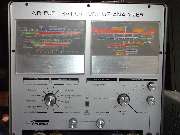 We refer to this tool as "the big Penske box". It includes a battery tester and many system electrical tests as well as exhaust gas analyzer. This tool has so far produced mixed results. It is available for the adventurous with no guarantees, as we have no trained technician to go with it (but there is a large instruction book). We might expect this tool to produce better or more consistent results as more people use it and become familiar with its operation. Feel free to pick it up and give it a try, and do let us know how it works for you. Also review E-Tuning tech day - October 2002.
We refer to this tool as "the big Penske box". It includes a battery tester and many system electrical tests as well as exhaust gas analyzer. This tool has so far produced mixed results. It is available for the adventurous with no guarantees, as we have no trained technician to go with it (but there is a large instruction book). We might expect this tool to produce better or more consistent results as more people use it and become familiar with its operation. Feel free to pick it up and give it a try, and do let us know how it works for you. Also review E-Tuning tech day - October 2002.

EXHAUST GAS ANALYZER #2:
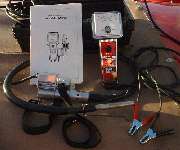 This is the newer one, tried and tested, easier to use and more consistent. (Translation: It generally works). KAL Equip model R-89 Portable Exhaust Analyzer. When you use this the first time, a five minute chat with our Tech Coordinator should get you off to a faster start. This one may be also attached to your car for test while driving. Also review E-Tuning tech day - May 2004.
This is the newer one, tried and tested, easier to use and more consistent. (Translation: It generally works). KAL Equip model R-89 Portable Exhaust Analyzer. When you use this the first time, a five minute chat with our Tech Coordinator should get you off to a faster start. This one may be also attached to your car for test while driving. Also review E-Tuning tech day - May 2004.

HYDRAULIC BODY STRAIGHTENING KIT:
 This tool is particularly good at pushing with great force. It has a hand operated hydraulic pump, a medium stroke hydraulic cylinder, and a variety of length and end attachments. It also has a powerful set of spreader fingers. If you have had one corner of your MG bashed out of alignment this may help you to get it back into shape. It may also handle some light frame straightening on your unibody car. Results will depend on how creative you are when push comes to shove. Thanks to CMGC member Dennis Trowbridge for contributing this tool.
This tool is particularly good at pushing with great force. It has a hand operated hydraulic pump, a medium stroke hydraulic cylinder, and a variety of length and end attachments. It also has a powerful set of spreader fingers. If you have had one corner of your MG bashed out of alignment this may help you to get it back into shape. It may also handle some light frame straightening on your unibody car. Results will depend on how creative you are when push comes to shove. Thanks to CMGC member Dennis Trowbridge for contributing this tool.

KINGPIN REAMER - MGB:
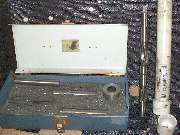 Our inventory of specialized tools includes an MGB KINGPIN REAMER. This is a delicate item that must be used correctly to
Our inventory of specialized tools includes an MGB KINGPIN REAMER. This is a delicate item that must be used correctly to
 avoid damaging it, so we will be especially diligent in ensuring that it is used correctly and returned in good condition. Contact the Tool Master for access and instructions.
avoid damaging it, so we will be especially diligent in ensuring that it is used correctly and returned in good condition. Contact the Tool Master for access and instructions.
Our thanks to MOSS MOTORS for their generosity in donating this item to the club.

KINGPIN REAMER - MG MIDGET:
 We also have a kingpin reamer for Spridgets (AH Sprite and MG Midget). See notes above about delicate tool and care in useage.
We also have a kingpin reamer for Spridgets (AH Sprite and MG Midget). See notes above about delicate tool and care in useage.

Our thanks to MOSS MOTORS for their generosity in donating this item to the club.

MIG WELDER:
The MIG Welder is quite popular these days. With the value of many of our favorite classic British Cars increasing it now pays to repair body damage
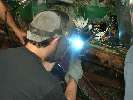
 rather than to dispose of a badly dented or rusted vehicle. Once the snips and chisel and plasma cutter have removed the offending bits of sheet metal the MIG welder does a smart job of stitching in the new pieces. In keeping with the easy to use and portable philosophy this tool is configured to run on a 120V - 15-amp standard household electrical circuit, so no special home wiring is required for its use. Novice welders can generally learn to use this tool with just a few minutes of practice. For the most part it's a point and pull the trigger device, with only a few small adjustments. See Cut and Weld tech session photos and notes.
rather than to dispose of a badly dented or rusted vehicle. Once the snips and chisel and plasma cutter have removed the offending bits of sheet metal the MIG welder does a smart job of stitching in the new pieces. In keeping with the easy to use and portable philosophy this tool is configured to run on a 120V - 15-amp standard household electrical circuit, so no special home wiring is required for its use. Novice welders can generally learn to use this tool with just a few minutes of practice. For the most part it's a point and pull the trigger device, with only a few small adjustments. See Cut and Weld tech session photos and notes.

PANEL NUT WRENCH:

 This tool is a faithful reproduction of the original Churchill tool used to remove and install the soft chrome-over-brass panel nuts for the dash switches. It works for all MG through 1967 (prior to the introduction of plastic rocker switches). The large end fits the ignition switch bezel. The small end fits pull switches and toggle switches. Now you can work with these slotted ring nuts without damaging the nut or the dash on your vintage MG. Thanks to British Tool Company for the donation of this tool.
This tool is a faithful reproduction of the original Churchill tool used to remove and install the soft chrome-over-brass panel nuts for the dash switches. It works for all MG through 1967 (prior to the introduction of plastic rocker switches). The large end fits the ignition switch bezel. The small end fits pull switches and toggle switches. Now you can work with these slotted ring nuts without damaging the nut or the dash on your vintage MG. Thanks to British Tool Company for the donation of this tool.

PLASMA CUTTER:
The plasma cutter is alive and well and is currently in use by this correspondent for an MGB rocker-dogleg-etc. replacement project. This is the first time I've actually used it for anything more than a demo
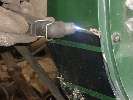
 and I am very impressed with it. The unit does require a strong compressor PSI and strong 120V - 15 amp current feed to operate correctly, and it is definitely not to be confused with a Jedi light-saber or the more traditional "hot knife through butter". However, as with any good tool, when used correctly it is an excellent aid to the process of removing and trimming sheet metal. And, Yes - it's true, the paint is not even bubbled or charred along the cut made by a plasma cutter.! See Cut and Weld tech session photos and notes.
and I am very impressed with it. The unit does require a strong compressor PSI and strong 120V - 15 amp current feed to operate correctly, and it is definitely not to be confused with a Jedi light-saber or the more traditional "hot knife through butter". However, as with any good tool, when used correctly it is an excellent aid to the process of removing and trimming sheet metal. And, Yes - it's true, the paint is not even bubbled or charred along the cut made by a plasma cutter.! See Cut and Weld tech session photos and notes.

REAR HUB SOCKET - MGA and early MGB:
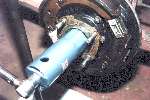
 This is the large special socket required to work the rear hub bearing nut on the MGA end the early MGB with banjo type rear axle. This includes all roadsters through 1965, and some roadsters from 1965-1967. No MGB GTs were fitted with the banjo type axle. It is a 1-61/64 inch 8-sided socket which accepts a 3/4 inch socket drive adapter or can be used with a round bar inserted through the side holes.
This is the large special socket required to work the rear hub bearing nut on the MGA end the early MGB with banjo type rear axle. This includes all roadsters through 1965, and some roadsters from 1965-1967. No MGB GTs were fitted with the banjo type axle. It is a 1-61/64 inch 8-sided socket which accepts a 3/4 inch socket drive adapter or can be used with a round bar inserted through the side holes.

SAND BLASTER
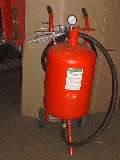 Anyone doing restoration work might have a use for this tool. With a pressure feed tank it can remove paint from steel in a flash, takes just a little longer to blow away scaley rust. From giving it a good workout I think it takes about 15-18 CFM of air at 70-90 PSI. My 2-HP compressor does 7.5 CFM at 90 PSI, so it can provide about 50% duty cycle while keeping the pressure up. Larger compressors are always good for sand blasting. There should always be a little blasting media in the tank for a small job. If you have a big job to do, buy your own blasting media, and please return the tool with something still in the tank for the next user. Click for more extensive notes on use of this tool.
Anyone doing restoration work might have a use for this tool. With a pressure feed tank it can remove paint from steel in a flash, takes just a little longer to blow away scaley rust. From giving it a good workout I think it takes about 15-18 CFM of air at 70-90 PSI. My 2-HP compressor does 7.5 CFM at 90 PSI, so it can provide about 50% duty cycle while keeping the pressure up. Larger compressors are always good for sand blasting. There should always be a little blasting media in the tank for a small job. If you have a big job to do, buy your own blasting media, and please return the tool with something still in the tank for the next user. Click for more extensive notes on use of this tool.

SODA BLASTER
 This tool is similar to the sand blaster but uses granular baking soda powder for the blasting media. We haven't tested it yet, but it may get a demonsrtation at the early June tech session in Glen Ellyn. As with the sand blaster, it needs an air compressor to work, and maybe about the same amount of air, around 15-18 CFM at 70-90 psi for continuous operation. It will work on proportionately shorter duty cycle with less air volume. The story is that it will remove paint from metal, plastic bumpers and glass without damaging glass or chrome. It could remove rust if using a more abrasive mix of media powder. It will do less damage to underlying metal, so it may be suitable for use on aluminum panels (proceed at your own risk). Thanks to Jim Dades for the donation of this tool.
This tool is similar to the sand blaster but uses granular baking soda powder for the blasting media. We haven't tested it yet, but it may get a demonsrtation at the early June tech session in Glen Ellyn. As with the sand blaster, it needs an air compressor to work, and maybe about the same amount of air, around 15-18 CFM at 70-90 psi for continuous operation. It will work on proportionately shorter duty cycle with less air volume. The story is that it will remove paint from metal, plastic bumpers and glass without damaging glass or chrome. It could remove rust if using a more abrasive mix of media powder. It will do less damage to underlying metal, so it may be suitable for use on aluminum panels (proceed at your own risk). Thanks to Jim Dades for the donation of this tool.

SPOT WELDER
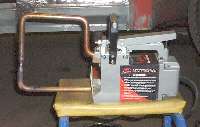 The spot welder is a self contained unit that works on a 115-volt 15-amp household electrical outlet (but should have a 20-amp fuse or circuit breaker). It has straight tongs for close quarters and a large offset tong to reach around larger things like door posts. Spot welding is quick asd easy where you have access to both sides of the metal. For more notes on use of this tool see
The spot welder is a self contained unit that works on a 115-volt 15-amp household electrical outlet (but should have a 20-amp fuse or circuit breaker). It has straight tongs for close quarters and a large offset tong to reach around larger things like door posts. Spot welding is quick asd easy where you have access to both sides of the metal. For more notes on use of this tool see
http://mgaguru.com/mgtech/restore/rt615.htm

STUD WELDER
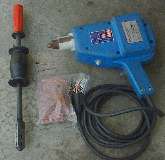 This nifty tool can make short work of pulling a dent out of your steel body panels (not aluminum). Sand the paint off down to bare metal. Put a copper plated nail (the stud) into the collet, place firmly against the panel for good electrical contact, pull the trigger for half a second, and it spot welds the stud to the sheet metal. Attach multiple studs as required. The small slide hammer has a collet to grip the studs so you can pull the metal up to the desired level. Then use an angle grinder to grind off the studs flush with the surface, just a few seconds per stud. This leaves the panel clean and smooth with no trace of the weld zone, ready for prep and finishing. Thanks to CMGC member Barney Gaylord for contributing this tool.
This nifty tool can make short work of pulling a dent out of your steel body panels (not aluminum). Sand the paint off down to bare metal. Put a copper plated nail (the stud) into the collet, place firmly against the panel for good electrical contact, pull the trigger for half a second, and it spot welds the stud to the sheet metal. Attach multiple studs as required. The small slide hammer has a collet to grip the studs so you can pull the metal up to the desired level. Then use an angle grinder to grind off the studs flush with the surface, just a few seconds per stud. This leaves the panel clean and smooth with no trace of the weld zone, ready for prep and finishing. Thanks to CMGC member Barney Gaylord for contributing this tool.
 For tech session photos and notes see
For tech session photos and notes see
www.chicagolandmgclub.com/photos/door04
TERMINAL CRIMPER
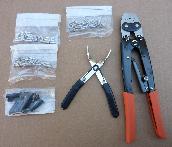 The club is now in possession of a wiring crimper tool designed for use with British “bullet” connectors. This is Moss #161-751 and comes with a small supply of both male and female connectors. Contemporary hardware store connectors will not mate to standard MG connectors; this tool will allow you to place new MG style bullets on frayed wire ends or to replace unusable female receptacles.
The club is now in possession of a wiring crimper tool designed for use with British “bullet” connectors. This is Moss #161-751 and comes with a small supply of both male and female connectors. Contemporary hardware store connectors will not mate to standard MG connectors; this tool will allow you to place new MG style bullets on frayed wire ends or to replace unusable female receptacles.

TIMING LIGHT
 This is an inductive pickup strobe light. It has pinch clamps for connection to power and ground and to clip onto the #1 spark plug wire. With the set-back dial you can check spark timing at higher engine speed to see maximum spark advance and check operation of mechanical and vacuum advance mechanisms. Thanks to CMGC member David Bralich for contributing this tool.
This is an inductive pickup strobe light. It has pinch clamps for connection to power and ground and to clip onto the #1 spark plug wire. With the set-back dial you can check spark timing at higher engine speed to see maximum spark advance and check operation of mechanical and vacuum advance mechanisms. Thanks to CMGC member David Bralich for contributing this tool.




 TOW BARS
TOW BARS
 The first two tow bars appear to be intended for use with chrome bumper cars with the bumper removed. They may not be suitable for highway use. Use and travel at your own risk.
The first two tow bars appear to be intended for use with chrome bumper cars with the bumper removed. They may not be suitable for highway use. Use and travel at your own risk.
Additionally, there is a third tow bar. Commercial universal tow bar configured with adaptor plates for use with late model rubber bumper MGB's. Requires removal of bumper for attachment. Requires standard hitch unit on towing vehicle. No electrical hookups but legal for street use otherwise.
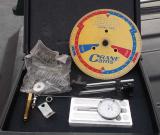
 Tune-A-Cam Tool Kit
Tune-A-Cam Tool Kit
This tool kit is used to dial in or "degree" a camshaft in your engine. This is an important custom adjustment for many upgrade camshafts which require cam timing to be diffferent than stock configuration. See the Crane Cams web site for instructions on use of this tool and Degreeing a camshaft the easy way. Thanks to CMGC member Barney Gaylord for contributing this tool.

VALVE GRINDER
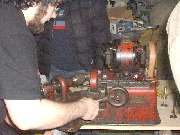 This one is old but solid, and is restored to good working condition. If you're touching up your cylinder head you can now clean up the old valves rather than buying new ones.
This one is old but solid, and is restored to good working condition. If you're touching up your cylinder head you can now clean up the old valves rather than buying new ones.
Lending Policy:
The club tools are intended for use by members of the Chicagoland MG Club when working on members cars. Please do not ask to borrow these tools if you are not a club member. The membership fee is small, and membership benefits are great, so for sure we can take care of that little problem in short order. You can just click on "Membership Application" here in the left column. You might also check on "Tech Sessions" there to see what's coming up, and remember that our friendly members are often willing to lend a hand with your project.
The club Tool Master is Jim Evans, and these tools are generally stored in Glen Ellyn, IL. Tools may be out on loan at any given time, so call ahead to check before making the trip. The number to call is (630) 858-8192. The tools are intended for short term lending only, and you are expected to return them promptly in good working condition and clean, whether your job is finished or not. If you borrow the engine hoist to pull your engine, and you expect the engine to be out of the car for more than a couple of days, then you should plan on immediately returning the hoist and borrowing it again later when the engine is ready to go back in. The same applies to all tools. Please do not keep these tools out of the crib for weeks at a time.

Future Tool Additions:
The Club is also open to suggestions for additional tools to add to the Program. Keep in mind the standard philosophy, moderately expensive, to be used only occasionally by any one person for very short term, easy enough to be used by an average shade tree mechanic, portable, and requiring no special adaptations for power supply, exhaust connections, and so on.
Good examples of what NOT to recommend would be ring compressor, torque wrench, clutch aligning tool - these are all inexpensive items that most hobby mechanics already have on hand. For this type of tool we recommend that you either buy your own or borrow one from a friend. In the latter case we would hope that you still have a friend by the time you are finished with the use of the borrowed tool.
For recommendations or inquiries you may contact Jim Evans by e-mail at
toolmaster@chicagolandmgclub.com or call (630) 858-8192.
|









 EMERGENCY FLASHER LIGHT:
EMERGENCY FLASHER LIGHT: 





 avoid damaging it, so we will be especially diligent in ensuring that it is used correctly and returned in good condition. Contact the Tool Master for access and instructions.
avoid damaging it, so we will be especially diligent in ensuring that it is used correctly and returned in good condition. Contact the Tool Master for access and instructions. 















